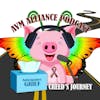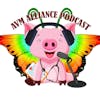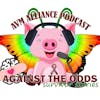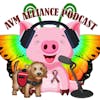Think TAAF
Today's episode includes a discussion on yesterday's MSN published article: “Doctors dismissed these 3 young people's symptoms as migraines or drug-related — but they were really having strokes.” We welcome guest Dina Chon with the Aneurysm and AVM Foundation and end with a short discussion on pain, perspective and PTSD as we finish chapter 4 of our focus book "Suffer Strong" by Kathrine and Jay Wolf.
Today's episode includes a discussion on yesterday's MSN published article: “Doctors dismissed these 3 young people's symptoms as migraines or drug-related — but they were really having strokes.” We welcome guest Dina Chon with the Aneurysm and AVM Foundation and end with a short discussion on pain, perspective and PTSD as we finish chapter 4 of our focus book "Suffer Strong" by Kathrine and Jay Wolf.
PSA Find Your Lifeline with TAAF: https://youtu.be/v0yhpua-078
The Aneurysm and AVM Foundation: https://taafonline.org/
Our FB Page: https://www.facebook.com/AVMAlliance
Our FB Group: https://www.facebook.com/groups/325321586185434
Instagram: https://www.instagram.com/avmalliance/
Twitter: https://twitter.com/avmawareness
Personal Blog: https://www.caringbridge.org/visit/kylerlewis
TIKTOK: https://www.tiktok.com/@avmsurvivor
Raylene Lewis: [00:00:00] Hi there, and thank you for joining us on AVM Alliance, a pediatric stroke podcast for families and friends whose lives have been affected by traumatic brain injury, brain vessel disease, or stroke. The purpose of this podcast is to focus on the kid's side of brain injury with honest Talk, news, information and discussion for our community. Being a parent of a medically complex child is an extremely difficult path to suddenly find yourself on. I'm Raylene Lewis and my son Kyler suffered a hemorrhagic stroke at age 15. Thank you for joining us. In brain News, I received an article from one of our listeners that was published yesterday by msn.
The headline reads, doctors dismissed these three young people's symptoms as migraines or drug related, but they were really having strokes. I was very happy to see something in the mainstream media about strokes occurring in [00:01:00] younger people and the awareness that young people who have a stroke are often prone to misdiagnosis.
In the article, two of the young stroke victims were diagnosed by doctors as having a migraine, and the doctor of the third was convinced that the patient had done drugs. I relate to this so much because this is exactly what happened in the case of my 15 year old son. We immediately rushed him to the doctor.
Within 20 minutes or so of the onset of his symptoms, but were told that he was suffering from a severe migraine. The doctor gave my kid a shot, told me to take him home and put him to bed. And when I questioned this diagnosis, I was told that if I wasn't convinced it was a migraine, I could make the choice to drive my kid to the hospital.
Which I did when we got there, the nurses were very nonchalant. They told me to have my kid pee in a cup, which we did right away. But I kept insisting drugs were not our problem. I felt truly ignored by both sets of [00:02:00] medical professionals, and it wasn't until they finally did a CT scan on my son that we got him the help he.
The CT showed he needed emergency brain surgery to relieve the pressure from the brain bleed. As yesterday's news article said, minutes matter in terms of saving brain tissue and brain function, and when it comes to stroke and younger patients. Doctors can overlook the signs and attribute them to more common culprits like stress, drug use, or migraines.
This is a huge reason why educating the public about childhood stroke is so very important. It's important to get the right help. Fast, and speaking of getting the right kind of help with me today is Dina Chan with the Aneurysm and AVM Foundation, who just recently put out a public service announcement about the importance of remembering taf.
When you are in need of help, I've included the link to the PSA in the podcast description below. When you think Care, community [00:03:00] advocacy Resources, research and awareness, TAF is that place. Dina, thank you so much for joining us today. I am so excited to have you here to talk about the aneurysm and AVM Foundation.
What a lot of people might not know is that right after Kyle's bleed when we left the hospital we were told that Kyler did not have any treatments that were available and when I got online and started, you know, trying to find a solution because no option was not an option for this mama. I came across you and TAAF.
So tell everybody a little bit about your organization.
Dina Chon: Well I just want everyone to know that if they haven't met you anyone telling you no is probably a really bad idea. , , it just activated you is what happened. That's true. So yeah, I'm the executive director at the Aneurysm and a V M Foundation or TAF for short, like such a mouthful, right?[00:04:00]
And I'm really lucky because I came to the organization from a place of loss having my mother pass away from a burst aneurysm on Christmas day when I was 16. And so I didn't, I didn't, couldn't have imagined actually that an organization like this really existed. The origin story of TAF is really lovely.
Basically an amazing neurosurgeon named, you know, Michael Lawton. We all know Mike Lawton. Was busy working his fanny off and being led in my mind, and probably his two by his nurse, which is Lisa Hannigan, and they're completely cognizant of the fact that. They get patients from point A to point B, and that B to Z is where they really have their lives.
And so they, they started a support group at U C S F and when newly diagnosed families and patients are out and, and they're looking for the right kind of people to lead them and to help them to really help them in their lives. They're the ones who found.
Raylene Lewis: [00:05:00] Oh, absolutely. We did. We found TAAF and you have a fabulous psa, right, that's come out that says Think TAAF.
Dina Chon: We do one of the prettiest fake doctors you've ever seen.
Raylene Lewis: . I'll be sure to include that in the link in the In the link.
Dina Chon: Yeah, exactly. We do. I am very much the. Sound piece, the leader, the cheerleader, the all the things for taf. I know that because we are 95% volunteer run, which is a completely unique it is so that when you've been served by TAF in some way, and then you meet that next person, you can say, here, let me send this tool to you so that you can find taf.
And that's the whole. Purpose. And everyone from you, you are in the PSA . Yes. Do all the way to Zach. I have two seconds of fame. . Yes, you're, it's beautiful. But from, from everyone start to finish saying, you know, Come here, find this lifeline. It's literally called, you know exactly that. Find your lifeline with taf.
And we want to be that. We want to serve people.
Raylene Lewis: Talk [00:06:00] to me really quick about the TAAF Youth Ambassador Program. This is something really unique that you guys offer.
Dina Chon: Thank you. I, I am so grateful for it too. So the Youth Ambassador program actually serves young people from ages 10 to 19. The program has modules that the young people go through every month.
It includes some really, I guess, outstanding opportunities for them to also create situations and opportunities within their community. So we really do encourage that. One of my favorite things. I anticipated it being probably just young people who were affected by the disease directly. Now we have siblings, we have young people whose parents are the ones directly affected.
And this year, this is the first year where we have two who want to be in the neurosurgery side of their as a career. And they have not been affected directly at all. Wow. And yet they're still amazing [00:07:00] advocates. These young people continue to bring ideas to the forefront. They interact with one another in a way that is beautiful and supportive, but they also get activated by us on occasion to go back out into their communities, to talk to directly affected children.
So that's the thing I wanna end with and highlight is that if, for example, Tyler wanted someone to talk to that really understood, not just kind of, because they're empathetic young people, but like actually understood because they also had an A V M, right? Right. We have So, and they're Coasta coast. These young people are Cosac coast one of them around the world actually.
And that is, Unbelievably impactful that I can as a 14 year old, 17 year old, 10 year old, I can talk to another person just like me. It's the reason that Tafts first venture in the world long before me was to [00:08:00] have a walk. They wanted to get people together, and I'm so grateful for all of them. I, I hope they hear that.
I, I hope one of them is like, I'll listen to this podcast, and they're like, oh my gosh. D just said how much she loves us. . .
Raylene Lewis: Well, you know, Kyle's sister Rilynn is a TAAF Youth ambassador.
Dina Chon: Yes, she is.
Raylene Lewis: And. She loves it and she feels like it's her way to kind of deal with her brother's diagnosis and, and try to help as much as she can.
So, in addition to the youth ambassador program, and by the way, that's a yearly thing, right? Like you take out Yes. Patients, what's mm-hmm. very briefly, how does that process work?
Dina Chon: Yeah, it's, it's just that it's application based, so they apply every year and some of them. In front of a committee. Some of them are approved by me directly.
Raylene Lewis: If you go online, something else that's amazing is that you guys have, is it TAAF for
kids? It is.
Dina Chon: Yeah.
Raylene Lewis: All right. So tell us a little bit about TAAF for Kids..
Dina Chon: We wanted to have a pediatric initiative, and we have one of the best[00:09:00] pediatric neurosurgeons on the west coast as part of our organization and neurologists, like, they're just an amazing group of people.
You've met them, like, you know, all these people. Absolutely amazing. They are, and we're like, how do we, how do we make sure that we begin to have a conversation? Pediatrics cuz it's very different. So it's a vehicle for people to be able to find the Youth ambassador program and to get connected. This is, it's all about connectivity.
Raylene Lewis: And you have a pet youth ambassador now, right?
Dina Chon: I don't know if he's a youth because like dogs are older, right? Like some Oh yes. My, yeah. Cause he might be the elderly TAAF Pet Ambassador. He's a pet star. So we do, we have a pet ambassador and his name is Marley. And actually what's great about all of this is that the youth Ambassador program has highlighted some of the most amazing ways that Taft serves because it's just replicated in a younger version.
Raylene Lewis: You have done a couple of get [00:10:00] togethers where other kids can all get online via Zoom,
right?
Dina Chon: We did kind of like an art related opportunity where you could sign up for a class there was photography, et cetera. And so they hosted that as well, where you could sign up that day, come to an event where they were also participating. So you might. In an art class with one of them and get to, you know, basically hang out without having brain aneurysm and AVM information like stuffed down your throat. I think that that is very, Important for this group, especially because they don't wanna be lectured to. Nobody wants to be lectured to.
But if we can meet you in a social way, it's so much more organic. It's more fun, I believe in edutainment. Right. So we're like educating you but also entertaining you
Raylene Lewis: Kyler participated in one where it was like, show your pet or something.
Dina Chon: Yeah, that one was super fun too. We had, oh my gosh, we had a petting zoo.
Raylene Lewis: That was right. It was an online petting zoo.
Dina Chon: It was a virtual petting [00:11:00] zoo, and it was amazing. And everyone brought something so different. One of the, the young men brought a, a snake. Do you remember that?
Raylene Lewis: I do. I do. Yeah. They had some really cute stuffed animals for the people that
stuffed animals.
Exactly. It was.
Dina Chon: Yeah. So don't dare me. Don't tell Raylene no and don't dare me to do something fun. Like those are the rules. ,you gotta have some fun when you have brain vessel disease. Fun in some places whenever possible is a requirement. Absolutely.
Raylene Lewis: Now speaking of like having the kids and everybody get together TAAF does a monthly thing for adults, right?
And that's your TAAF support group meeting. Can you talk a little bit about.
Dina Chon: I can. So just as I said at the top of this Lisa and Mike had, you know, created this on the ground support group. Well, so many amazing things have come out of Covid time. You know, like our magazine talk about heart projects.
I just kept starting it and putting it back on the shelf. But [00:12:00] Zoom became part of everyone's life and I made a very conscious decision right off the bat like we had been. Support group had been happening on a monthly basis before TAF existed. I was not gonna stop doing it. We would figure this out.
And so we started having it over Zoom. Then we just recently, in the last six months have two sessions, so it's six. PM on the East coast, then later at 6:00 PM on the West coast. The greatest thing about it is that you have legacy people. There are people still in this group who have been there before TAF existed.
To me, that's, it blows me away because that means we have consistently been of service to them for over. 18 years. Like that's, that's just amazing to me that someone that, not someone, someone's plural, that people continue to come back because they find so much good in this. And it is the model that we're trying to replicate, as you know.
For our [00:13:00] youth side, it's much harder to start a youth support group. Young people don't necessarily want to go to support group, so you have to again, kind of edu Right. But the support group is wonderful. We have a lot of People will come in and talk to us, which is great. So we bring in a lot of speakers.
When I bring in folks to talk to support group, they have thousands of questions and it's a really giving safe, amazing place. And there's a newbie every time. We always have new folks come in. I love it. I love hosting support group.
Raylene Lewis: I think it's just a very welcoming environment and it's great for caregivers, you know, to listen to and for.
Dina Chon: You're making such a good point because it's, it's absolutely a thousand percent not just like survivors or Right. Just newly diagnosed. It is every section of this community. Every section, there are sometimes physicians who have come in to hear other physicians talk. Like it's, yeah, it's a great group.
Raylene Lewis: Speaking of physicians, cause I know we're getting short on time when [00:14:00] people, you know, you tell 'em you want them to think TAAF when they have issues or they have questions or they want another opinion. Talk about how, what, what TAAF can offer to parents who are trying to find the right treatment for their kids.
Dina Chon: Will you above anyone know how this worked? So I'm gonna use you as a little bit of a, a template, but essentially what TAF does is we offer individualized, Resource support. It means that a real person, this is my legacy building. Okay? When my mother passed away, there was nothing. There were no resources.
There was no one to explain to us how to move on in life and let alone what happened to her . So, as a newly diagnosed person as Kyler was newly diagnosed, when you found us, we stopped a physical person. In this example, it was me, real one, a real actual person. And we spoke often actually, you and I spoke all of the time, and anyone who's ever got an [00:15:00] email from me also gets my cell phone number because we want people to have that connectivity.
You should never, ever, once you found half, you should not feel alone. There's no reason. You always have a way to get in touch with us. So what we began doing is really reaching. Coast to coast to different people that you and I, and I do this all the time, had identified as possible folks for you to talk to.
These were typically neurosurgical teams. Yeah. And it's essentially how to help find second opinions. And one of the things that I think. Newly diagnosed, especially the parents don't know, like why would they, is that people want to help them , right? They keep coming up against these walls of, oh, that AVM isn't treatable, or that brain, how does your kid have a brain aneurysm?
We don't see children very often, right? Yeah. All of these, especially if you're in a rural situation. Oh my gosh. But the reality is that especially on the AVM side, you [00:16:00] want to hit neurosurgical centers. Do this all day, every day. Avm A V M A V M, and I just happen to be lucky enough to be able to know who they are, talk to these people, they wanna be helpful, and we start to connect those folks and.
It's a very easy process. It does it in your case, , I actually made you create a spreadsheet because yes. Ultimately you were vetting way more people than I would've wanted you to.
Raylene Lewis: I know. I'm sorry I had paralysis. But after analysis
Dina Chon: yes, analysis paralysis because it does become very hard. One of the things that I would share with your listeners is, In the all physicians that are worth anything want you to have a second opinion because they want you to feel confident in the decisions that you are making.
They are if, if you ever, I don't care if you're going in for a broken finger or like brain surgery, if someone says, oh, why would you get a second opinion? You are not in the right place for you. Right. That's all right. And so it's important to know that [00:17:00] the decision making process is supposed to be initial, right?
So you get an initial diagnosis of, let's say there's zero treatment option. That stinks. So then you get a second opinion, and that one is supposed to be compared to the first. So in other words, if you get a neurosurgeon, which is an extraordinary. Smart and learned person who agrees with the first opinion.
You probably can be done because you have two extremely amazing people agreeing this. The hard part about a v m is that they're all these tiny little you know, snowflakes. They're very different, every single one of them. And so a third opinion can be you know, achieved if the second opinion differs.
And that's where you and many people do start to get a little Put off because now you're getting lots of different opinions, right? So the more complicated your A V M, the more complicated the treatment option might be. But what you need to hear is that TAAF is gonna be there along that [00:18:00] process forever.
As long as we are needed, we will be with people, you know? And so I think that that's, That's really at the core of think taf. If you are in need of a resource, think taf. If you are feeling low and you really need to talk to someone who's been in your switch situation, pardon me, you know, think taf, all of these different ways, that's what we do.
We care individually for every single person as often and as completely as we.
Raylene Lewis: You absolutely do. And you know, in, in my defense, I had a lot of people telling me a lot of different things. So Dina, of course you did. I mean, Dina walked me through, I had 16. 16 neurosurgeons because my kids' a v m is very complex.
But now for thinking TAAF where does somebody go?
Dina Chon: I would say my favorite things are when someone tags me out on social media somewhere, because inevitably what we'll they'll do and they've learned or I've taught them, is just to send them [00:19:00] immediately my email. Like, why not? Like, just have them email me.
But if someone were to randomly go on like taf online.org, which is our website, there's a contact opportunity there. If you're out, let's say like on Instagram, you can find us directly from, you know, all of that LinkedIn bio. We are going to be everywhere. What we are gonna do is we're gonna try to help you find places that are local places that absolutely have given the thumbs up that yes, they wanna participate by us sending, you know, other people and connecting them to their programs.
But you wanna find places that do it. all day. Every, like, that's their thing. You want to go to neurosurgical centers and centers of excellence. So
Raylene Lewis: centers who specialize in your kid's condition, whatever it is.
Dina Chon: Correct, correct. And that's not to, you know, in some way give a rural hospital, you know, a hard time.
But I will tell you that. From my experience, these centers of excellence, just, they just have done them more [00:20:00] often. You can have it extraordinarily, you know, amazing. Fill in the blank here with whatever kind of physician you're looking at in where I was, Princeton, Illinois, like tiny bone, little tiny tone.
You know, but he or she probably has. Two AVMs as opposed to someone in a center of excellence that's done two today, . Yeah. Like that's, that's all it is, you know? And so I, I do not want to ever appear to say like, you know, one is better than the other. They're all amazing centers and all neurosurgeons.
And they're neurot staffs in every way. Neurologists, all of these people. Are the bread and butter of getting you from point A to point B. We wanna make sure that TAAF helps you from B to Z.
Love it. Love it.
Raylene Lewis: And again, if somebody wants to reach you, they can go to taaf online.org or is that just the best way and hit contact
Dina Chon: or find, I think that that's, yeah, it's super easy cuz it doesn't come directly to me.[00:21:00]
Raylene Lewis: Well thank you so very much for joining us today.
Dina Chon: Really appreciate it Raylene. Always helpful. Really thanks.
Raylene Lewis: In chapter four of our focus books suffer. Jay discusses pain and perspective. He points out the word trauma will often stir up deep emotional responses because on some level, all of us, everyone has experienced trauma perspective and trauma he says is required for cultivating self-awareness.
Gratitude and growth outside of our own tendency towards self-focus. If we look at our trauma and the trauma around us from a broader perspective, we as a people will realize we are not alone in our feelings of what is happening to us, and this helps us to remove the idea of seeing ourselves as victims.
What Jay is saying here is that there will always be harder stories than ours, and there will always be easier ones. It is up to us to figure out what we are going to do with our trauma. Jay says, the [00:22:00] world is not safe yet. When we isolate ourselves from the possibility of harm, we also deprive ourselves of the beauty our brokenness can display and we dismiss the powerful experience of resilience.
Just because one person's pain might not be the worst case scenario doesn't mean that it is still not pain, and none of us need to apologize to. Ourselves included for the stories that we've been given. The biggest challenge is how to maintain hope while coping with unwanted realities. P T S D isn't just for folks coming back for more.
It's also for those who have fought against life's hardest experiences. The takeaway is that trauma can open up a different way of living, a way that might lead to a life more fully. And one with fewer regrets on the end. Suffering in general can force life stresses and distractions to fall away, inviting us to a clearer view of the things in life that matter Most.[00:23:00]
Today's quote is by Lori Goodwin. Even in times of trauma, we try to maintain a sense of normalcy until we no longer can that my friends is called surviving, not healing. We never become whole again. We are survivors. If you are here today, you are survivor, but those of us who have made it through hell and are still standing, We bear a different name.
Warriors. I always like to end our time together with a motivational song recommendation. I don't play the song because of copyright laws, but there have been many times on this journey where a song has really spoken out to me and helped me with my day. Today I'm recommending you check out the single burn the ships, the three R H A B remix version by King and Country that came out in 2019.
Step into a new day. We can rise it from the dust and walk away, light a match, burn the ships, and don't you look back. [00:24:00] And as always, if you have questions, have a topic you would like to hear about, or a great song or motivational. Don't be shy. Share in the comments and let us know. And if you liked what you heard today, please go online and rate this podcast.
Remember, you're never walking this journey alone. Take care of all.
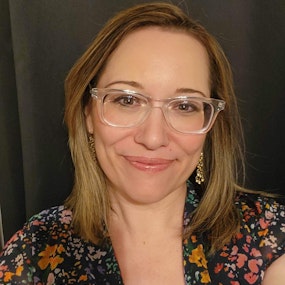
Dina Chon
Executive Director
After losing her mother to a burst aneurysm on Christmas Day when she was 16, Dina has tried to honor that legacy of love in all of her work but especially within the greater aneurysm and AVM community.





























